 Halo: Reach finishes the story that game developer Bungie began nearly a decade ago. The newest Halo video game for the Xbox 360 is the last that Bungie will make for Microsoft. After that, it moves on to a new universe. It feels like we’re seeing an old friend for the last time before they move on to a new life.
Halo: Reach finishes the story that game developer Bungie began nearly a decade ago. The newest Halo video game for the Xbox 360 is the last that Bungie will make for Microsoft. After that, it moves on to a new universe. It feels like we’re seeing an old friend for the last time before they move on to a new life.
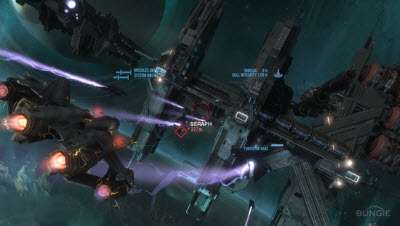 This game fits into the epic story arc, taking you right back to the beginning of the events leading up to first Halo game released in 2001. If you’re a Halo fan, you already know how this game will end without even playing it, because it is a prequel. That gives the game an overarching sense of fatalism. You can only be so happy when things turn out good for the good guys since you know they’re part of a losing cause. As much as I’m happy to play another Halo, I’m sad that it’s all coming to an end, for now. (Microsoft has a new internal team, 343 Industries, working on other Halo titles, even as Bungie moves on to something new.)
This game fits into the epic story arc, taking you right back to the beginning of the events leading up to first Halo game released in 2001. If you’re a Halo fan, you already know how this game will end without even playing it, because it is a prequel. That gives the game an overarching sense of fatalism. You can only be so happy when things turn out good for the good guys since you know they’re part of a losing cause. As much as I’m happy to play another Halo, I’m sad that it’s all coming to an end, for now. (Microsoft has a new internal team, 343 Industries, working on other Halo titles, even as Bungie moves on to something new.)
The game’s story is based on the novel, Halo: The Fall of Reach, the first in a series of books set in the Halo universe. But even if you know the ending will be tragic, you still want to follow the journey. It is a tale worth telling, full of heroism, much like how Homer’s Iliad begins in the midst of the Trojan war and ends before the fall of Troy. As on the plains of Troy, Halo: Reach is the scene of individual acts of heroism in the context of a larger war. The death of each hero is a tragedy unto itself, amid a battlefield of unnumbered tears. It makes you feel like, even though you as the player have a bit role on a vast stage, you are at the critical point in a great war.
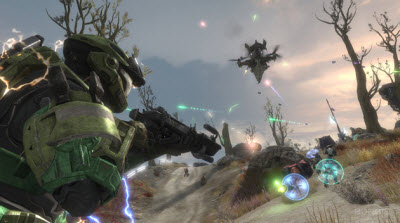 The book chronicles the creation of the Spartan III warriors, an elite group of fighters who are humanity’s best hope against the Covenant, the collection of alien races who are bent on wiping out humankind. To the aliens, the planet Reach is just another place to be “glassed,” or laid waste via wholesale destruction. It is the last stopping point on the way to Earth and home to the military command of the United Nations Space Command, or UNSC, which holds the human galaxy together. The planet is beautiful, full of natural landscapes and big cities, and in sweeping scenes Bungie reminds us now and then that it has created an entire planet. The new game takes place on Reach, but it does not follow the story of the book, which explains the slight difference in the titles between the game and the novel.
The book chronicles the creation of the Spartan III warriors, an elite group of fighters who are humanity’s best hope against the Covenant, the collection of alien races who are bent on wiping out humankind. To the aliens, the planet Reach is just another place to be “glassed,” or laid waste via wholesale destruction. It is the last stopping point on the way to Earth and home to the military command of the United Nations Space Command, or UNSC, which holds the human galaxy together. The planet is beautiful, full of natural landscapes and big cities, and in sweeping scenes Bungie reminds us now and then that it has created an entire planet. The new game takes place on Reach, but it does not follow the story of the book, which explains the slight difference in the titles between the game and the novel.
Halo’s critics say there isn’t enough new material in each new Halo game. But to me, Halo games are always fresh because they’re mash-ups of my favorite things. The Halo games consistently please with their combination of game play, intensity, story, music, sound, graphics, and excellent voice acting. I don’t see too much reason to mess with that formula in the name of providing something different. Halo games are memorable for their unique and unmistakable experiences, and this one is no different. I give it a rating of 95 out 100 — near perfect, but with a few small flaws.
 The cultural phenomenon of Halo
The cultural phenomenon of Halo
The Halo: Combat Evolved, Halo 2, and Halo 3 games starred Master Chief and his artificial intelligence companion, Cortana. This game does not. But that doesn’t seem to bother fans, who bought more than 3 million units of the game in its first 24 hours as it went on sale Sept. 14. The game generated more than $200 million in revenue on its first day, compared to $170 million for Halo 3. Microsoft calls it the “entertainment event of the year,” eclipsing the three-day opening box office receipts of Iron Man 2, Toy Story 3, and Alice in Wonderland.
The original Halo became such a smash hit that it established Microsoft’s place in the video game industry. It helped the Xbox cement its place among hardcore game fans, becoming part of the mass culture for a whole generation. More than 36 million units have been sold, generating revenue in excess of $2 billion. Microsoft has the No. 1 online game service in Xbox Live because of the Halo series, and that service is now generating $1 billion a year in revenue.
You don’t get to this level of business success on pure hype; you have to make your game into a cultural phenomenon. Bungie did so by making a series of good choices. Bungie, a developer of games for the Mac, envisioned the original Halo in the late 1990s. Ed Fries, former head of Microsoft Game Studios, scooped up Bungie for less than $30 million in 2000 as one of many bets on Xbox-related content. That deed earned him an angry call from Steve Jobs and a promise that Microsoft would support Mac games. The Bungie team, headed by Jason Jones, Alex Seropian and Joseph Staten, rewrote the game for the Xbox. Marty O’Donnell provided a musical score worthy of an opera. And in less than 11 months, they created a launch title that was played by 80 percent of the people who bought the first Xbox.
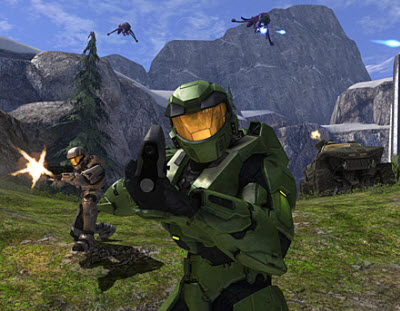 The first game pulled together a lot of different pieces of the video game art form. Bungie figured out how to make a first-person shooter game work on the game console, providing just enough assistance so that it was possible to hit targets with a game controller instead of a mouse and keyboard. That may not sound like a big deal, but it was huge, setting the stage for the mass migration of shooter fans from the PC to the console. Many other games tried but failed to capture the right nuances for controlling a weapon with a game controller with buttons and analog sticks.
The first game pulled together a lot of different pieces of the video game art form. Bungie figured out how to make a first-person shooter game work on the game console, providing just enough assistance so that it was possible to hit targets with a game controller instead of a mouse and keyboard. That may not sound like a big deal, but it was huge, setting the stage for the mass migration of shooter fans from the PC to the console. Many other games tried but failed to capture the right nuances for controlling a weapon with a game controller with buttons and analog sticks.
The story of the original game was inspiring, the pace was pulse-pounding, the sound was riveting, and the music was haunting and lofty. You could jump into vehicles that had realistic physical behavior, and the setting on the ring-like planet Halo was breathtaking, from the waterfalls in its first scene to the indoor scenes of vast Covenant spaceships. All of these things explained why the first game was such a masterpiece, and the continued care and feeding of the franchise has created fans who will buy anything made by Bungie. That’s why Lord of the Rings director Peter Jackson is working on a Halo movie.
It’s hard to believe Bungie is walking away from all that in the hopes of building something better. I savored this game, playing it over the course of a week, rather than powering through it in a couple of nights as I did with Halo 3. I knew this game would be the last of its kind. I played the new game on the Heroic setting, which is one step above Normal and is the most appropriate setting for gamers who have played Halo before. It took me about a week of one- and two-hour game sessions to finish the single-player campaign. The salve for me is that I can play the multiplayer version for weeks or months.
The nuts and bolts of Halo: Reach
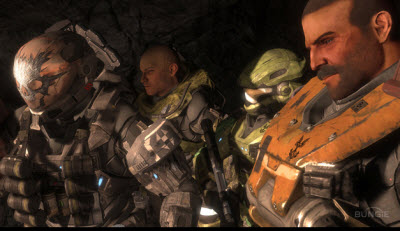 The main job of this prequel is to set the stage for Master Chief and his story. The action is intense, and it’s almost always preceded by long cinematic segments (mini films, really) that convey the latest twists in the story. You find that, besides defending Reach, you have to keep the enemy from getting its hands on the vital secrets of the Office of Naval Intelligence and the research of Catherine Halsey, the creator of the Spartans.
The main job of this prequel is to set the stage for Master Chief and his story. The action is intense, and it’s almost always preceded by long cinematic segments (mini films, really) that convey the latest twists in the story. You find that, besides defending Reach, you have to keep the enemy from getting its hands on the vital secrets of the Office of Naval Intelligence and the research of Catherine Halsey, the creator of the Spartans.
While there are nine major levels in the single-player campaign, each section is divided into its own set of chapters with pithy titles like “And the horse you rode in on.” With each new level, the game introduces you to a new feature or ability. In the very first level, the new feature is companions. You are introduced as Noble 6 (either male or female, depending on your own choice), the new replacement for a team of five Spartans. Each of the characters has a different specialty. You learn what those abilities are in the initial firefights where you learn the Covenant have invaded Reach. You could think of Noble Team as The Six Samurai (modeled after Akira Kurosawa’s classic film, the Seven Samurai).
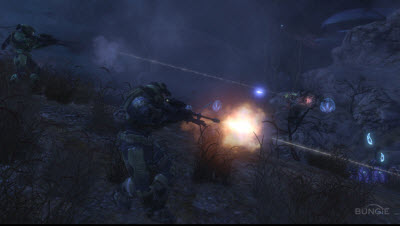 I quickly found that I needed those companions just to stay alive. I had to play some sections of the game at least 10 times before I could proceed to the next section. It seems a lot tougher than past Halo games, in part because of the addition of new enemies that are tougher to kill than usual. The fighting is gritty. You have to fire at enemies a lot of times before they die, first knocking out their shields and then taking them out. In the meantime, other enemies surround you. You have to toss grenades at the tougher ones and switch weapons as needed. Inevitably, the fighting gets so close that you have to butt them with your gun in a desperate melee. That is business as usual for Halo.
I quickly found that I needed those companions just to stay alive. I had to play some sections of the game at least 10 times before I could proceed to the next section. It seems a lot tougher than past Halo games, in part because of the addition of new enemies that are tougher to kill than usual. The fighting is gritty. You have to fire at enemies a lot of times before they die, first knocking out their shields and then taking them out. In the meantime, other enemies surround you. You have to toss grenades at the tougher ones and switch weapons as needed. Inevitably, the fighting gets so close that you have to butt them with your gun in a desperate melee. That is business as usual for Halo.
The second level, dubbed Nightfall, introduces more breadth of play as you have to be a sniper, quietly taking out Covenant sentinels. It is here where you first use the hologram. When you tap your left bumper, the hologram sends out a decoy version of a Spartan that draws the fire of enemies. It turns out to be most effective later in the game when you are fighting the tank-like Hunters, which can only be taken out from behind.
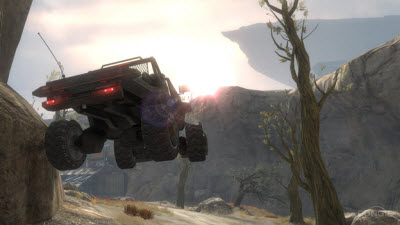 In quick succession, you get to experience new levels in Warthogs (which are dune buggy style vehicles with big guns mounted on the back), helicopter gunships, tanks, and the final frontier — space combat. The space scenes are some of the best I’ve played in a sci-fi game. You shoot off into space in a rocket in a very dramatic liftoff scene. Then you have to fight other spacecraft that are attacking a human space station. While other games have failed to get the mechanics of flight simulation right, Bungie has made it easy and natural in Halo: Reach. Just as it made the controller work in shooting targets, it has also made the controller work really well as a flying instrument. You spend most of your time aiming, steering and shooting. You don’t have to worry as much about accelerating or decelerating.
In quick succession, you get to experience new levels in Warthogs (which are dune buggy style vehicles with big guns mounted on the back), helicopter gunships, tanks, and the final frontier — space combat. The space scenes are some of the best I’ve played in a sci-fi game. You shoot off into space in a rocket in a very dramatic liftoff scene. Then you have to fight other spacecraft that are attacking a human space station. While other games have failed to get the mechanics of flight simulation right, Bungie has made it easy and natural in Halo: Reach. Just as it made the controller work in shooting targets, it has also made the controller work really well as a flying instrument. You spend most of your time aiming, steering and shooting. You don’t have to worry as much about accelerating or decelerating.
The space combat scene is followed by a firefight in zero gravity. There is no sound in this battle, and the physics of zero gravity change the way you fight. You can jump and fly forever, or toss a grenade that goes for a great distance. It’s one more element that makes you feel like you’re playing a brand new game, not the sixth game in a series.
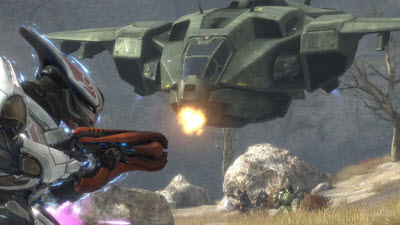 The game isn’t perfect
The game isn’t perfect
The characters of Noble team get more airtime than the usual video game side kicks. But I miss the personality of the wise-cracking and emotional Cortana, who constantly accompanied Master Chief. In Halo: Reach, when the Spartans take off their masks, they reveal their own unique character traits. The problem is they are all of the tough-as-nails Marine variety. You get to know these characters a little, but the common trait they share is the courage to sacrifice themselves for other members of the team or the larger mission. If there is a flaw in the game, it is that you don’t get to know them nearly as well as you get to know the characters in games such as BioWare’s Mass Effect 2, which is another of the great games of the year.
The characters come and go. And you don’t learn much about your own character at all. In other words, there is too much action, and not enough back story to each of the samurai. I guess that means that Bungie should have added more cinematics to the story. As with the long cut scenes in Uncharted 2: Among Thieves (the best game of 2009), the movie part of the Halo: Reach game could have conveyed more character depth and thus more emotional attachment. Thanks to its flaws, it’s no surprise that Halo: Reach is coming in slightly below the review scores for the first three Halo games and below games such as Mass Effect 2 or Red Dead Redemption.
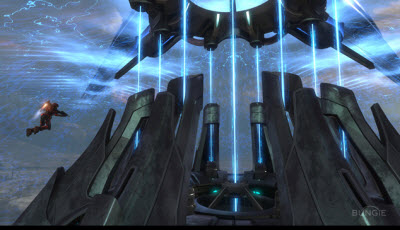 As far as game play goes, Bungie took away what it gave in Halo 2 with dual-wielding, or the ability to hold a weapon in each hand. That turned out to be far too powerful in the hands of veterans playing multiplayer games. And it made the single-player campaigns much too easy as well. In this game, you can tap new options such as load-outs with different weapons. You can use different enhancements for your armor, such as lock-down mode, which makes you invincible for a few seconds. You can also fly around with a jet pack for a limited time, or sprint at double speed for a burst of time. By and large, this is a good trade. But players may feel frustrated they can’t dominate the Covenant as they once did.
As far as game play goes, Bungie took away what it gave in Halo 2 with dual-wielding, or the ability to hold a weapon in each hand. That turned out to be far too powerful in the hands of veterans playing multiplayer games. And it made the single-player campaigns much too easy as well. In this game, you can tap new options such as load-outs with different weapons. You can use different enhancements for your armor, such as lock-down mode, which makes you invincible for a few seconds. You can also fly around with a jet pack for a limited time, or sprint at double speed for a burst of time. By and large, this is a good trade. But players may feel frustrated they can’t dominate the Covenant as they once did.
Multiplayer promises to offer billions of hours of fun
I am looking forward to playing a lot more multiplayer. You can play different versions such as Capture the Flag or classic Slayer (where you kill everybody). The new features such as jet packs will get a lot of use in the multiplayer combat. Multiplayer is always a joy because you get rewards and rankings based on your performance. With the new Forge mode, you can create your own maps for multiplayer combat. And with Theater, you can watch your own achievements and tell the world about them. When it comes to sharing, Bungie is on top of social media.
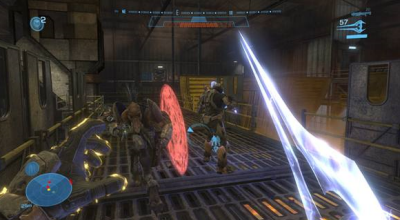 I started my first multiplayer game with the expectation that I would be slaughtered over and over. I actually managed to come in second place, mainly because I got my hands on a sword that gave me the ability to slay the enemy with a single stroke. The multiplayer gaming is what justifies the game price of $60 or more. Gamers have spent billions of hours playing Halo games online, and this one is likely going to be very similar. Overall, this multiplayer interface is much more streamlined. It matches you with other players quickly and it loads fast. That’s pretty impressive, considering that millions of players are going to be playing it all at once.
I started my first multiplayer game with the expectation that I would be slaughtered over and over. I actually managed to come in second place, mainly because I got my hands on a sword that gave me the ability to slay the enemy with a single stroke. The multiplayer gaming is what justifies the game price of $60 or more. Gamers have spent billions of hours playing Halo games online, and this one is likely going to be very similar. Overall, this multiplayer interface is much more streamlined. It matches you with other players quickly and it loads fast. That’s pretty impressive, considering that millions of players are going to be playing it all at once.
An opening for another sequel
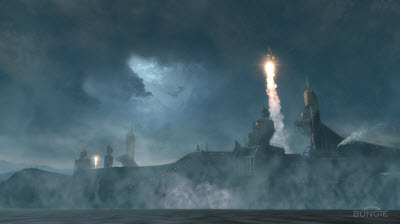 Is the ending worthy of the Halo reputation? I won’t spoil it. But it is familiar in that everything comes to a spectacular head where much is at stake and the hero has to save everything, at great sacrifice. In that way, the story is very similar to that of Red Dead Redemption, which is also one of the best games of the year.
Is the ending worthy of the Halo reputation? I won’t spoil it. But it is familiar in that everything comes to a spectacular head where much is at stake and the hero has to save everything, at great sacrifice. In that way, the story is very similar to that of Red Dead Redemption, which is also one of the best games of the year.
Not all ends in disaster for all of the characters in the Halo: Reach game. A couple of characters separate from the group in what seems to be a path for a sequel to Halo: Reach. If Microsoft continues with the Halo: Reach story, it could pursue the path taken by those characters. Given that there are seven novels now, Microsoft’s internal studio, 343 Industries, could take many different story paths. Bungie created an entire universe and Microsoft could publish a game every year and still not run out of material for games.
Halo: Reach is one more example of how the Halo universe could stay with us for many years to come. Whatever Bungie is working on for its new universe, it better be good. Because they’re walking away from a game franchise that has won loyal fans like no other series. I’m glad that Bungie has delivered a great game for its Halo swan song. But I’m still hungry for more adventures and frenetic game play. That’s the mark of an outstanding game. Bungie is quitting the Halo universe while it’s still in top form.
VentureBeat's mission is to be a digital town square for technical decision-makers to gain knowledge about transformative enterprise technology and transact. Learn More
